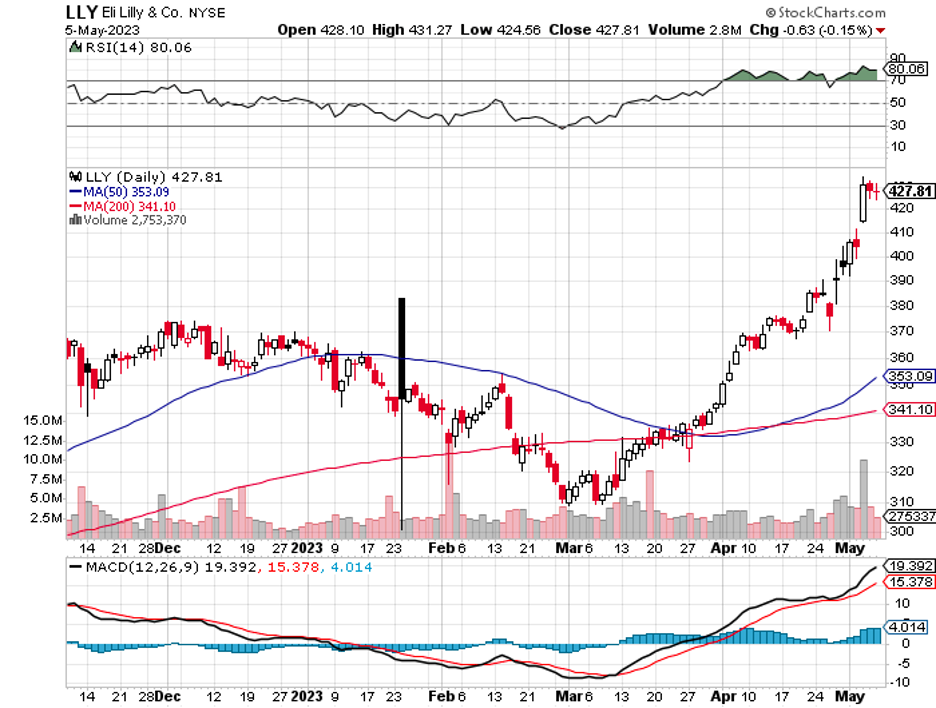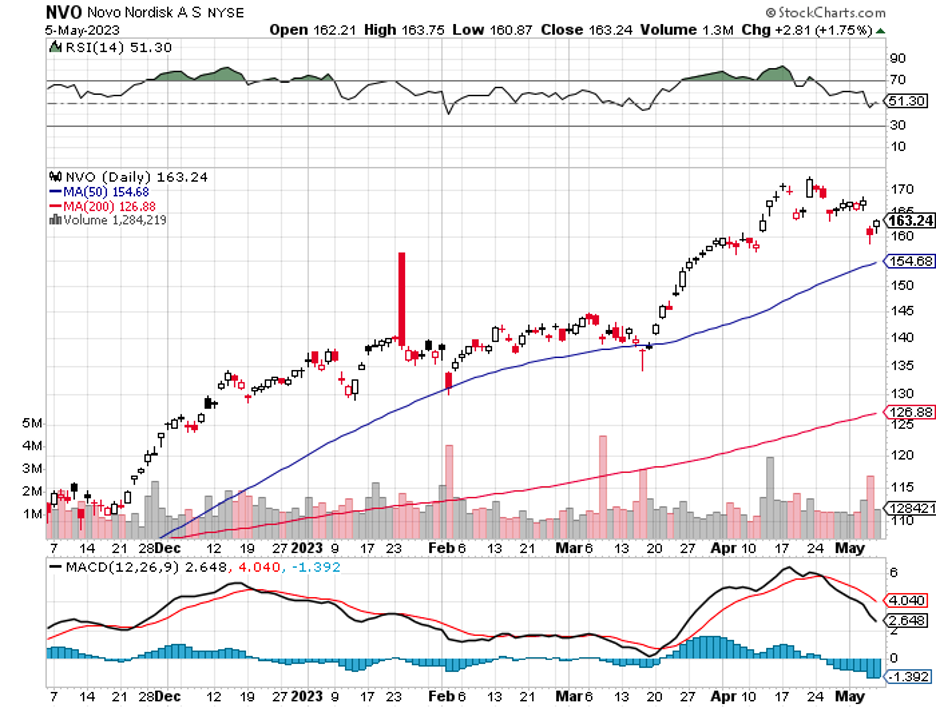Selling hot products and crushing the competition is where the real money's at. However, the challenge is to avoid falling for the hype. You need to assess a company's growth to know if it's worth investing in for the long haul.
If you have heard of tirzepatide, then you know that this drug has taken the pharma world by storm, making Eli Lilly (LLY) the talk of the town. In fact, this popular treatment helps patients drop more than 20% of their weight. No wonder it's got everyone hyped up.
But it's not just Eli Lilly that's causing a stir. Novo Nordisk (NVO) has a similar drug that's making waves, too.
In the world of pharmaceuticals, few drugs have generated as much buzz as Lilly's tirzepatide and Novo's semaglutide. These medications are projected to be among the top sellers of the decade.
These game-changing treatments have joined the ranks of iconic meds like the birth control pill, Prozac, and Pfizer’s (PFE) Viagra.
As expected, the share prices of both Eli Lilly and Novo Nordish have gone through the roof. They're already valued at around $400 billion each, placing them right behind industry leader Johnson & Johnson (JNJ).
Still, drug development is unpredictable.
A recent reminder of this was the biotech company Altimmune's (ALT) disclosure in March that a significant number of patients in a closely watched trial of its new weight-loss drug dropped out due to gastrointestinal issues.
That’s why it's essential to distinguish between opportunity and hype. More importantly, it’s critical to determine what exactly makes Lilly's tirzepatide and Novo's semaglutide so game-changing.
First, it's crucial to know that these two drugs come in various forms and are marketed for different conditions.
Novo's semaglutide is sold under the names Ozempic and Wegovy for Type 2 diabetes and obesity treatment, respectively, as well as Rybelsus, a pill for Type 2 diabetes. Lilly's tirzepatide, on the other hand, is currently only available as Mounjaro, an injection for Type 2 diabetes, but may soon have a new name added to the roster.
The real revolutionary aspect of these drugs is their effectiveness in lowering blood sugar and promoting weight loss. They mimic natural hormones that stimulate insulin production and slow digestion, making people feel fuller for longer.
Weight loss has long been a tricky area for drug development, with previous attempts being either ineffective or dangerous, resulting in many weight loss drugs being removed from the market.
But these drugs from Novo and Lilly are proving to be safe, albeit with significant side effects, and their efficacy is impressive.
In one trial, patients using Lilly's tirzepatide lost an average of 22.5% of their body weight, while patients on Novo's semaglutide lost 14.9% of their body weight in a separate trial. By comparison, a previous Novo drug called Saxenda only cut patients' body weights by 7.4%.
Another pressing question is about the availability of these drugs.
Mounjaro and Novo's Ozempic, Wegovy, and Rybelsus are already available on the market but have been in high demand and short supply.
To address this issue, both companies have announced plans to increase production. In April, Novo revealed that it had secured a new contract manufacturer, while Lilly has stated that it plans to double its production capacity for Mounjaro and similar drugs by the end of 2023.
Considering the market size and potential for these treatments, it comes as no surprise that competitors are already emerging.
Pfizer is currently developing a similar pill to tirzepatide and semaglutide, while Amgen (AMGN) is testing a weight-loss drug that uses a different mechanism.
Lilly has other weight-loss drugs in its pipeline, including a pill called orforglipron, which could launch in 2027. This is projected to generate $9.9 billion in sales in 2030.
Despite the emergence of competition, the weight-loss market is substantial enough to accommodate several drugs. Sales of obesity drugs are estimated to reach $30 billion by 2030, not including the Type 2 diabetes indication.
It's no secret that obesity and Type 2 diabetes are among the most prevalent health issues affecting millions worldwide. But did you know that the combined market for drugs targeting these conditions is expected to skyrocket to $90 billion globally by 2030?
Given the alarming statistics provided by the Centers for Disease Control and Prevention, such a staggering figure is not hard to fathom.
Almost 42% of American adults are obese, and about one in ten have diabetes. No wonder drug companies are racing to develop effective treatments to cater to this massive patient pool.
But what's interesting is that these drugs, which are not curative, could be a cash cow for pharmaceutical companies, as patients will likely need to take them for a long time.
This is why it’s easy to be bullish on the earnings potential of drugs like Mounjaro, with estimates for peak sales ranging from a heady $100 billion a year to a still impressive $40 billion.
In the pharmaceutical industry, buzz-worthy drugs are a dime a dozen, but game-changing medications that can revolutionize an entire market are few and far between.
Lilly's tirzepatide and Novo's semaglutide are just that.
These drugs have demonstrated significant weight loss in patients and are projected to be top sellers for the next decade. Despite the risks, Lilly and Novo's drugs are impressive, as they mimic natural hormones in the body, stimulate insulin production, and slow digestion to promote weight loss.
With the weight-loss market projected to reach staggering amounts by 2030, the potential is significant, but drug development is unpredictable, and competitors will inevitably emerge. Needless to say, investors must determine if these drugs' sky-high expectations are already factored into current share prices or if there's still room for growth.
While the weight-loss drug race is far from over, it’s clear that Lilly and Novo are off to a good start.


